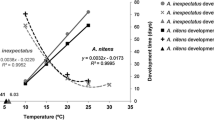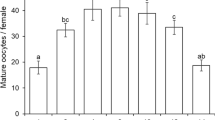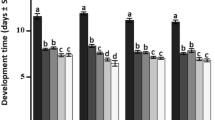Abstract
Diaprepes abbreviatus is an exotic root weevil occurring in southern US. It is a highly polyphagous species which can complete its entire life cycle on citrus and several woody ornamental plants. The lack of native egg parasitoids for this weevil in citrus orchards has triggered efforts to evaluate candidate egg parasitoids from the Caribbean Region into Florida. The egg parasitoids Fidiobia dominica and Haeckeliania sperata are two exotic natural enemies of D. abbreviatus recently introduced in the US in a classical biological control program. The thermal requirements of both parasitoids were studied in the laboratory. The upper development threshold (UDT) of F. dominica was 30.0°C, its maximal development rate (MDR) occurred at 27.6°C, its lower development threshold (LDT) was 9.6°C and its thermal constant (K) for development from egg to adult was 293.1 DD. For H. sperata, UDT was 35.0°C, MDR occurred at 31.0°C, LDT was around 15°C and K was 188.1 DD. Based on these results, both species would be able to complete 17 to 18 generations annually in southern Florida. However, host availability during critical periods could severely impair the ability of these egg parasitoids to establish and successfully control D. abbreviatus in areas where winter temperatures fluctuate around 12°C, the LDT for this pest.



Similar content being viewed by others
References
Anonymous (2005) Southeast Regional Climate Center. Historical Climate Summaries for Florida http://www.dnr.state.sc.us/climate/sercc/climateinfo/historical/historical_fl.html. (10/13/05)
Beavers JB, Lovestrand SA, Selhime AG (1980) Establishment of the exotic parasite Tetrastichus haitiensis (Hym: Eulophidae) and recovery of a new Trichogramma (Hym: Trichogrammatidae) from root weevil egg masses in Florida. Entomophaga 25:91–94
Castillo J, Jacas JA, Peña JE, Ulmer BJ, Hall DG (2006) Effect of temperature on life history of Quadrastichus haitiensis (Hymenoptera: Eulophidae), an endoparasitoid of Diaprepes abbreviatus (Coleoptera: Curculionidae). Biol Control 36:189–196
Evans GA, Peña JE (2005) A new Fidiobia species (Hymenoptera: Platygastridae) reared from eggs of Diaprepes doubleirii (Coleoptera: Curculionidae) from Dominica. Fla Entomol 88:61–66
Godfray HCJ (1994) Parasitoids. Behavioral and evolutionary ecology. Princeton University Press, Princeton
Goolsby JA, DeBarro PJ, Kirk AA, Sutherst RW, Canas L, Ciomperlik MA, Ellsworth PC, Gould JR, Hartley DM, Koelmer KA, Naranjo SE, Rose M, Roltsch WJ, Ruiz RA, Pickett CH, Vacek DC (2005) Post-release evaluation of biological control of Bemisia tabaci biotype “B” in the USA and the development of predictive tools to guide introductions for other countries. Biol Control 32:70–77
Grafton-Cardwell E, Godfrey K, Peña JE, McCoy C, Luck R (2004) Diaprepes root weevil. ANR Publ. No. 8131. University of California, Oakland
Hall D, Peña JE, Franqui R, Nguyen R, Stansly P, Mccoy C, Lapointe S, Adair R, Bullock B (2001) Status of biological control by egg parasitoids of Diaprepes abbreviatus (Coleoptera: Curculionidae) in citrus in Florida and Puerto Rico. BioControl 46:61–70
Hall DG, Eger J, Peña JE, Duncan RE, O’Brien C, Evans G, McCoy C (2002) Exploration in Belize for parasitoids attacking eggs of citrus weevils and an evaluation of Pediobious irregularis and Horismenus bennetti (Hymenoptera: Eulophidae) as potential biological control agents of Diaprepes abbreviatus and Pachnaeus litus (Coleoptera: Curculionidae). Fla Entomol 85:663–666
Jacas JA, Peña JE, Duncan RE (2005) Successful oviposition and reproductive biology of Aprostocetus vaquitarum (Hymenoptera: Eulophidae): a predator of Diaprepes abbreviatus (Coleoptera: Curculionidae). Biol Control 33:352–359
Jacas JA, Peña JE, Duncan RE (2007) Morphology and development of the immature stages of Fidiobia dominica Evans & Peña (Hymenoptera: Platygastridae: Sceliotrachelinae). Ann Ent Soc Amer (in press)
King BH (1987) Offspring sex ratios in parasitoid wasps. Q Rev Biol 62:367–396
Knapp J (1985) The citrus root weevils in Florida: an extension service perspective. Fla Entomol 68:368–370
Lactin JD, Holliday NJ, Johnson DL, Craigen R (1995). Improved rate model of temperature-dependent development by arthropods. Environ Entomol 24:68–75
Lapointe SL (2001) Effect of temperature on egg development of Diaprepes abbreviatus (Coleoptera: Curculionidae). Fla Entomol 84:298–299
Lapointe SL, Borchert DM, Hall DG (2007). Effect of low temperatures on mortality and oviposition in conjunction with climate mapping to predict spread of the root weevil Diaprepes abbreviatus and introduced natural enemies. Environ Entomol 36:73–82
Llàcer E, Urbaneja A, Garrido A, Jacas JA (2006) Temperature requirements may explain why the introduced parasitoid Quadrastichus citrella (Hymeoptera: Eulophidae) failed to control Phyllocnistis citrella (Lepidoptera: Gracillariidae) in Spain. BioControl. 51:439–452
Logan JA, Wallkind DJ, Hoyt SC, Tanigoshi LK (1976) An analytic model for description of temperature-dependent rate phenomena in arthropods. Environ Entomol 5:1133–1140
Peña JE, Amalin DM (2000) Biological control of Diaprepes abbreviatus by parasitoids. In: Futch SH (ed) Diaprepes short course, Cooperative Extension Service Florida Agricultural Experiment Station. Citrus Research & Education Center, Lake Alfred, pp 66–76, March 2000
Peña JE, Etienne J, Duncan RE, Pinto J (1998) Introduction of Ceratogramma etiennei (Hymenoptera: Trichogrammatidae) for biological control of Diaprepes abbreviatus in Florida, USA. In: Hassan S (ed) Egg parasitoids, 5th international symposium. IIBC, Cali, pp 145–148
Schroeder WJ, Hamlen RA, Beavers JB (1979) Survival of Diaprepes abbreviatus larvae on selected native and ornamental Florida plants. Fla Entomol 62:309–312
Simpson SE, Nigg HN, Coile NC, Adair RA (1996) Diaprepes abbreviatus (Coleoptera: Curculionidae): Host plant associations. Environ Entomol 25:333–349
Skaria M, French JV (2001) Phytophthora disease of citrus asssociated with root weevils in Texas. Phytopath 91 (supplement S203)
Stanley D (1996) Suppressing a serious citrus pest. Agric Res 44:22
STSC (1987) Statgraphics user’s guide, version 5.0. Graphic Software System STSC Inc., Rockville, MD
Timmer LW, Rogers ME, Buker RS (2005) Florida citrus pest management Guide. University of Florida Cooperative Extension Service, Institute of Food and Agricultural Sciences. SP-43. http://edis.ifas.ufl.edu (03/24/07)
Ulmer BJ, Jacas JA, Peña JE, Duncan RE, Castillo J (2006) Effect of temperature on life history of Aprostocetus vaquitarum (Hymenoptera: Eulophidae), an egg parasitoid of Diaprepes abbreviatus (Coleoptera: Curculionidae). Biol Control 39:19–25
Varley GC, Gradwell GR, Hassell MP (1974) Insect population ecology, an analytical approach. University of California Press, Berkeley and Los Angeles
Woodruff RE (1964) A Puerto Rican weevil new to the United States (Coleoptera: Curculionidae). Florida Dept Agr Div Plant Ind Entomol Circ 30:1–2
Woodruff RE (1985) Citrus weevils in Florida and the West Indies: preliminary report on systematics, biology, and distribution (Coleoptera: Curculionidae). Fla Entomol 68:370–379
Acknowledgments
We are grateful to A. Urbaneja (Institut Valencià d’Investigacions Agràries, Spain), J. Capinera (University of Florida) and S. Lapointe (USDA, ARS) for critical review of the manuscript. Special thanks are extended to J. Alegría, Z. Alegría, and D. Long (UF-TREC) for providing technical assistance throughout the investigation. Research was supported by UF-IFAS, USDA, CSREES, and TSTAR.
Author information
Authors and Affiliations
Corresponding author
Rights and permissions
About this article
Cite this article
Jacas, J.A., Peña, J.E., Duncan, R.E. et al. Thermal requirements of Fidiobia dominica (Hymenoptera: Platygastridae) and Haeckeliania sperata (Hymenoptera: Trichogrammatidae), two exotic egg parasitoids of Diaprepes abbreviatus (Coleoptera: Curculionidae). BioControl 53, 451–460 (2008). https://doi.org/10.1007/s10526-007-9082-4
Received:
Accepted:
Published:
Issue Date:
DOI: https://doi.org/10.1007/s10526-007-9082-4




